Zacharias, Jesus' dad?
Actually, I arrived at this subject by accident. Clues which suggest that Zacharias was the father of both John the Baptist and Jesus. I thought it interesting, so I started to do some reading up on the subject. And then I discovered confirmation after confirmation that at least people in the past actually thought this, people like Poussin, Da Vinci, Michelangelo, and... the abbé Saunière of Rennes-le-Chateau. I decided to do some proper research, to see what I would come up with.
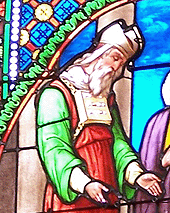 Zacharias was a Zadokpriest in the Temple, with Zadok hat and A'aron's breastplate and all. However, he was also the uncrowned Hasmonean king of Israel. Under Roman command he was only allowed to fulfil his Temple duties. He was married to Elizabeth, who was having such trouble in giving him an heir. Elizabeth was heir of the bloodline of A'aron the Zadok. Together with Zacharias, Elizabeth would make it possible for an heir, to become both king of Israel as well as Zadok priest. The more the pity that she could not give Zacharias his heir. That was a big problem! No Zadok and no king of Israel when Zacharias would pass away.
Zacharias was a Zadokpriest in the Temple, with Zadok hat and A'aron's breastplate and all. However, he was also the uncrowned Hasmonean king of Israel. Under Roman command he was only allowed to fulfil his Temple duties. He was married to Elizabeth, who was having such trouble in giving him an heir. Elizabeth was heir of the bloodline of A'aron the Zadok. Together with Zacharias, Elizabeth would make it possible for an heir, to become both king of Israel as well as Zadok priest. The more the pity that she could not give Zacharias his heir. That was a big problem! No Zadok and no king of Israel when Zacharias would pass away.
Solution: Elizabeth had a family member (a cousin, presumably), called Mary. Also Mary was heir to the bloodline of A'aron. So Elizabeth agreed to give Mary to Zacharias, similar to what Sara did at first, when she could not give Abraham his heir. I recently stumbled upon a beautiful fresco which seems to suggest that this idea is not so far fetched:
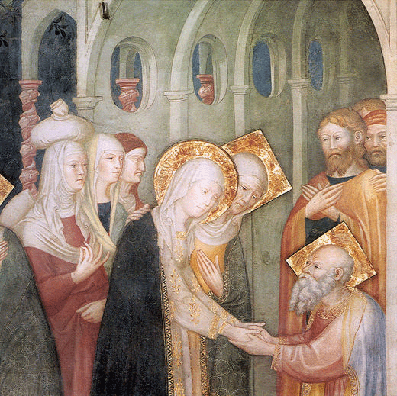
Lorenzo and Jacopo Salimbeni are the painters of this fresco. Here we see Elizabeth giving Mary to Zacharias. Note the squares around the heads of Zacharias and Elizabeth. These squares tell us that these two were married. Also note the pregnant woman behind Mary. She is making a gesture which symbolically suggests sexual intercourse. The crossed arms of the man behind Zacharias symbolises the unity of male and female.
In the church of the abbey of st. Hilaire near Limoux we see a statue of Mary, making the same gesture:
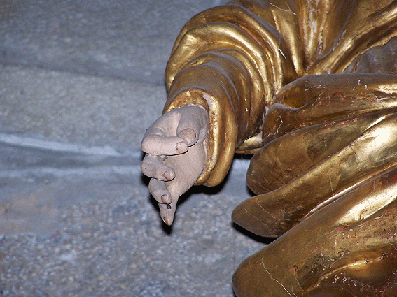
So when the deed was done, and Mary was pregnant, it appeared that Elizabeth was also pregnant! The Bible is convinced that John was born first. Both pregnancies were not so far apart if this story is true. John and Jesus would be of the same age, save perhaps a month or two. According to the New Testament, Mary and Elizabeth were in the house of Zacharias together during their pregnancies.
It seems very cruel, that Mary, immediately after Elizabeth gave birth to a healthy baby boy called John, was quickly married off to a man called Joseph, and sent away, probably to Egypt (the Essene community near Alexandria). Were they in danger and was their trip to Egypt merely a safety plan to escape Herodes? We may never know. But when Mary gave birth to a healthy baby boy as well, they named him Immanuel. Not Jesus. Also this can be found in the New Testament.
His name would then have been Immanuel ben Zahari, or something close to that.
About John's childhood we know very little. They will have cherished the boy. And after Zacharias was killed (he was murdered in the Temple when he did not want to betray the whereabouts of his wife and son), John and his mother Elizabeth would have continued to lay low. Most probably also in Egypt with the Essenes (the Essene scrolls speak of Lake Mareotis near Alexandria). It would also explain why some people believe that John was an Essene. John would reappear in the stories when he was about 30 years old, in Israel, giving his people comfort, support and faith, and he introduced baptism, a ritual he will have picked up in Egypt. Baptism, you see, was quite popular around Lake Mareotis at the time.
So John was not an old hairy wild man, but a king's son, who did nothing but try to give people hope, comfort and wisdom during the harsh years of the Roman repression, which was heavy for the people of Israel. Every riot was squashed violently. The royal family was watched very carefully and the Romans feared plots. So, one would have to be very very careful. Especially when you were the original ruler of the usurped land.
When John was becoming popular, Jesus arrived at the scene. He called himself Oshu (in Aramaic), which would become Jesus in Greek. Like his half brother John he tried to give his people wisdom, comfort as well as healing (something he had perhaps picked up in his years in India or Egypt, while he was away). The people of Israel were a bit confused having two uncrowned kings who each wanted to become the hope of the people. So, Jesus had a group of followers, and John had his group.
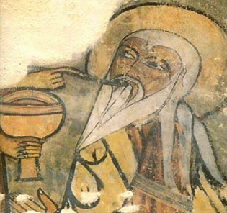 When John was beheaded, Jesus was the only one left to inherit the position of uncrowned king as well as Zadok priest. According to the New Testament, he was anointed by Mary Magdalene, who had to be his wife to be allowed to do this. And thus, Jesus became the Christ / Messiah, the anointed but still uncrowned king of Israel. Dutifully he also did the Zadok rituals. We know this from the Last Supper. For many millennia, bread and wine were the sacred tools in this ritual. Changing these into the body and the blood of the Mother Goddess was already done at the time of Abraham by Melchizedek (Michel Zadok).
When John was beheaded, Jesus was the only one left to inherit the position of uncrowned king as well as Zadok priest. According to the New Testament, he was anointed by Mary Magdalene, who had to be his wife to be allowed to do this. And thus, Jesus became the Christ / Messiah, the anointed but still uncrowned king of Israel. Dutifully he also did the Zadok rituals. We know this from the Last Supper. For many millennia, bread and wine were the sacred tools in this ritual. Changing these into the body and the blood of the Mother Goddess was already done at the time of Abraham by Melchizedek (Michel Zadok).
This ritual passed on through the ages to A'aron, being the Zadok high priest next to Moses.
When a Zadok priest was also a Nazarene (which has nothing to do with Nazareth but with Essene ranks), he was called 'Son of God'. This does suggest that Jesus was also a Nazarene. So, this is how Jesus became the king of the Jews (mocked by the Romans for his impure parent relations), the 'Son of God' according to Nazarene rule, and the Messiah or Christ which both means 'the anointed one'. He became the anointed king of Israel: le 'Christ Roi'...
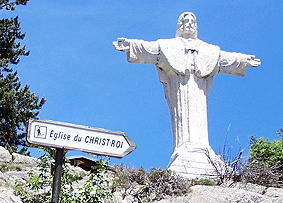
That is quite something! He was obviously no poor carpenter's son. That is something that the Roman catholic church invented to make him beloved by the masses, who were poor. Nobility wasn't popular in the early Christian period and the early Middle Ages, so the true nobility of Jesus was kept silent.
Also during his crucifixion, something that tells us that the Romans did not accept him as the king that he was, they mocked him with the title INRI. Iesu Nazareni Rex Iudorum. Jesus Nazarene, king of the Jews. Perhaps this knowledge can be seen as proof, that Jesus tried to be what he was born to be. A king trying to guide his people like a shepherd guides his flock. The kings of Israel, weren't they called the 'shepherd kings'? The Lord is my shepherd?
Now the Romans dealt with both king's sons. (After the crucifixion, Essene scrolls tell us, Oshu lived in Carmel like a Greek philosopher with a small class until his late seventies or early eighties. In any event, Jesus disappeared from the scene.) However, what about the royal family, and his possible heirs? Was this the reason why the royal family fled to the south of France, to the Essene communities in Occitania? Quite possible! Large groups of people had fled to these regions, especially in the first century, and there were several large Essene communities in the Languedoc-Roussillon at the time. And, nobility married nobility. A bloodline going back to Jesus would not be historically unthinkable. On the contrary, it is quite logical!
So: Perhaps there were people (Templars perhaps?) who stumbled upon the real bloodline of Jesus and thus discovered that his dad was Zacharias? The infamous parchment of Jesus' genealogy? And how do we find this in the church of Rennes-le-Château?
Now we must look through the ages, in search for symbolism in e.g. paintings and churches, who could support or confirm the above.
I would like to start with Nicolas Poussin. If he has the key, I immediately think of the Edinburgh painting.

Here, you see 3 interesting things.
First of all I noticed how the tomb on the right, behind Jesus, is the tomb of none other than Zacharias. It can still be seen in Jerusalem.
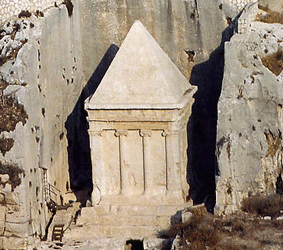
Second I noticed how the person who is John the disciple looks very much like a woman, perhaps also here it is Mary Magdalene, who is watching with horror how Jesus gives the key to Peter and not to her. A bit of irony from Poussin perhaps?
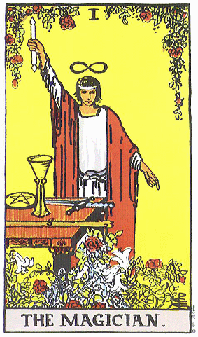 The third is also interesting:
The third is also interesting:
Jesus is the Magician of the Tarot!
But in mirror image!
If you look at the meaning of the Tarot's Magician in reverse, you get 'deception'.
Conclusion:
We have been deceived, the pyramid tomb points towards Zacharias.
John / Mary Magdalene is pulling a face, raising her arms slightly, as if she says 'why weren't the keys given to me?'
And if we see a painting of the Holy Family, we see, many times, only Zacharias, Elizabeth, Mary and the two boys. No Joseph. Interesting!
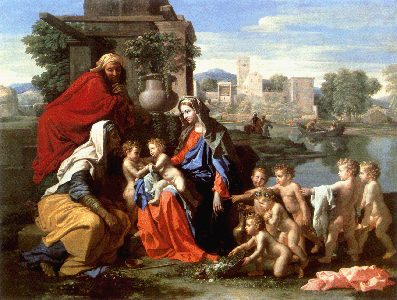
We go to Leonardo Da Vinci. Now we may understand exactly what this great man meant, when he painted his famous John the Baptist!
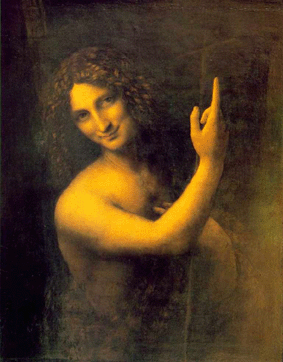
"I was king first!"
Did the abbé Saunière of Rennes-le-Château not put the Alpha underneath John at first? In stead of underneath Jesus, on the statues of John and Jesus in the church?
And what else can we see, when we look at these statues?
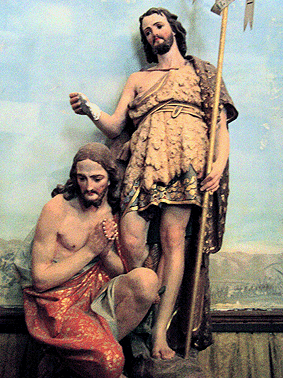
Here we clearly see, that John is wearing underneath his camel skin, a beautiful king's robe. Not so strange, because historically he was, after Zacharias' death, the legitimate king of Israel. A hint, clearly given by Saunière.
Discovery in Rennes-le-Chateau
On Thursday 18th June 2009, we spent almost the entire afternoon with our dear friend Henry Lincoln in Rennes-le-Château, and we have also gone into the church to hear him tell his stories. He came to station 6 of the cross, where he told us the story of the discovery of the real meaning behind the symbolism of this particular station. That you would have to turn a quarter, look or go to an enclosure, go down and look to the left. On his discovery he went towards an enclosure, the cemetery, he went to the bottom of the cemetery, and looked to the left. He said that it took him 20 years to find out that there was really nothing else to be seen but the views of the landscape.
Later that afternoon, my sister and I were in the church trying to escape the heat of the Summer sun. I just had to go back to station 6, and make the quarter turn on the spot. I found myself looking at an enclosure, the enclosure that surrounds the statues of Jesus and John. So I squatted, looked to the left and what did I see? A secret piece of Jesus' robe, which is exactly like that royal robe John is wearing!
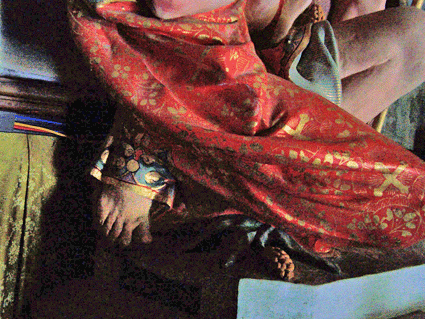
Both gentlemen are wearing, underneath their public clothes, their true clothes. The royal robe.
Both were royal princes until their dad Zacharias was murdered. John was the oldest, so he was king first, before Jesus took over after John was beheaded. It is obvious that also Saunière thought this. Otherwise he would not have hidden this detail so cleverly in his church. And Henry was clever enough to see the true meaning of station 6 at the time, or I would not have noticed the secret piece of Jesus' robe!
What does this mean for the church?
The Christian church in any form today cannot be blamed for the dogma's and doctrines which were created and used in the early Middle Ages for marketing and power strategy, so that the ancient Roman Empire could continue to exist in religious form. On the contrary. Now, their chickens have come home to roost! What are they to do with the truth of the first century and their own version of it, which was formed in the last 1800 years. Their story, which has taken root, cannot be changed, nor can their doctrines or dogma's be reversed, without losing face, and without risking the fall of Christianity itself. Jesus' divination, the resurrection, the virgin birth, all of these things have grown into the Christian faith so deeply, that many people consider this as the absolute truth. But, is this so wrong? As long as there is freedom for others to find their own truth?
Jesus' resurrection could, however, be replaced by the ancient concept of reincarnation. This was suppressed by the church to make room for the unique case of Jesus' resurrection. Whether Jesus died on the cross or not, would then no longer be an issue, because reincarnation explains that there is a cycle of rebirth and Karma cleansing.
A brave catholic priest has (in 2007 and in my presence), given Mass at Easter in public, where he preached not the material but the immaterial resurrection of Christ. So yes it can, slowly but surely, be replaced by a concept which would fit much better the evolution of human consciousness today.
Also, Jesus dying on the cross for our redemption, can also be replaced by another concept. Jesus clearly taught the Hermetica to his followers. The Hermetica is The Way to cleanse your Karma and Soul, and living according to its laws is always beneficial to us.
Son of God? Well of course this man was divinely inspired. People like Jesus and Buddha were very special. They preached peace in a violent world. Forgiveness when there was hate. Wisdom when there was ignorance. Understanding and comfort when there was confusion. Acceptation when there was irritation. And most of all, love when there was anger.
The church in the 21st century can handle the transformation towards the truth. It just needs time and courage, but it is absolutely possible.
Throughout the centuries, people like the Cathars have chosen the old Gnostic Christianity above Rome's power plans. To walk in the footsteps of Jesus, independent of Rome, thousands of followers died horrible deaths protecting what they believed in. They are the true martyrs of Christendom. Perhaps this is the reason why mystical catholic priests in the Languedoc-Roussillon have left so many hints and clues in their churches, so that the truth that lies underneath, will never be forgotten. They hid their clues cleverly, visual only to those who could understand the symbolism.
Solis Sacerdotibus.
On February 23rd, 2013, I was interviewed on a live TV talk show in Las Vegas about my novel White Lie, and the secrets of Occitania. To see the interview, click here. ~ www.jeannedaout.com
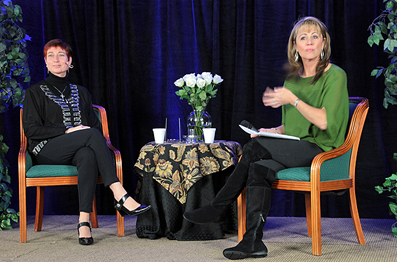
On the 10th of June 2009 I uploaded this little film on YouTube. Enjoy!
 Zacharias was a Zadokpriest in the Temple, with Zadok hat and A'aron's breastplate and all. However, he was also the uncrowned Hasmonean king of Israel. Under Roman command he was only allowed to fulfil his Temple duties. He was married to Elizabeth, who was having such trouble in giving him an heir. Elizabeth was heir of the bloodline of A'aron the Zadok. Together with Zacharias, Elizabeth would make it possible for an heir, to become both king of Israel as well as Zadok priest. The more the pity that she could not give Zacharias his heir. That was a big problem! No Zadok and no king of Israel when Zacharias would pass away.
Zacharias was a Zadokpriest in the Temple, with Zadok hat and A'aron's breastplate and all. However, he was also the uncrowned Hasmonean king of Israel. Under Roman command he was only allowed to fulfil his Temple duties. He was married to Elizabeth, who was having such trouble in giving him an heir. Elizabeth was heir of the bloodline of A'aron the Zadok. Together with Zacharias, Elizabeth would make it possible for an heir, to become both king of Israel as well as Zadok priest. The more the pity that she could not give Zacharias his heir. That was a big problem! No Zadok and no king of Israel when Zacharias would pass away.Solution: Elizabeth had a family member (a cousin, presumably), called Mary. Also Mary was heir to the bloodline of A'aron. So Elizabeth agreed to give Mary to Zacharias, similar to what Sara did at first, when she could not give Abraham his heir. I recently stumbled upon a beautiful fresco which seems to suggest that this idea is not so far fetched:

Lorenzo and Jacopo Salimbeni are the painters of this fresco. Here we see Elizabeth giving Mary to Zacharias. Note the squares around the heads of Zacharias and Elizabeth. These squares tell us that these two were married. Also note the pregnant woman behind Mary. She is making a gesture which symbolically suggests sexual intercourse. The crossed arms of the man behind Zacharias symbolises the unity of male and female.
In the church of the abbey of st. Hilaire near Limoux we see a statue of Mary, making the same gesture:

So when the deed was done, and Mary was pregnant, it appeared that Elizabeth was also pregnant! The Bible is convinced that John was born first. Both pregnancies were not so far apart if this story is true. John and Jesus would be of the same age, save perhaps a month or two. According to the New Testament, Mary and Elizabeth were in the house of Zacharias together during their pregnancies.
It seems very cruel, that Mary, immediately after Elizabeth gave birth to a healthy baby boy called John, was quickly married off to a man called Joseph, and sent away, probably to Egypt (the Essene community near Alexandria). Were they in danger and was their trip to Egypt merely a safety plan to escape Herodes? We may never know. But when Mary gave birth to a healthy baby boy as well, they named him Immanuel. Not Jesus. Also this can be found in the New Testament.
His name would then have been Immanuel ben Zahari, or something close to that.
About John's childhood we know very little. They will have cherished the boy. And after Zacharias was killed (he was murdered in the Temple when he did not want to betray the whereabouts of his wife and son), John and his mother Elizabeth would have continued to lay low. Most probably also in Egypt with the Essenes (the Essene scrolls speak of Lake Mareotis near Alexandria). It would also explain why some people believe that John was an Essene. John would reappear in the stories when he was about 30 years old, in Israel, giving his people comfort, support and faith, and he introduced baptism, a ritual he will have picked up in Egypt. Baptism, you see, was quite popular around Lake Mareotis at the time.
So John was not an old hairy wild man, but a king's son, who did nothing but try to give people hope, comfort and wisdom during the harsh years of the Roman repression, which was heavy for the people of Israel. Every riot was squashed violently. The royal family was watched very carefully and the Romans feared plots. So, one would have to be very very careful. Especially when you were the original ruler of the usurped land.
When John was becoming popular, Jesus arrived at the scene. He called himself Oshu (in Aramaic), which would become Jesus in Greek. Like his half brother John he tried to give his people wisdom, comfort as well as healing (something he had perhaps picked up in his years in India or Egypt, while he was away). The people of Israel were a bit confused having two uncrowned kings who each wanted to become the hope of the people. So, Jesus had a group of followers, and John had his group.
 When John was beheaded, Jesus was the only one left to inherit the position of uncrowned king as well as Zadok priest. According to the New Testament, he was anointed by Mary Magdalene, who had to be his wife to be allowed to do this. And thus, Jesus became the Christ / Messiah, the anointed but still uncrowned king of Israel. Dutifully he also did the Zadok rituals. We know this from the Last Supper. For many millennia, bread and wine were the sacred tools in this ritual. Changing these into the body and the blood of the Mother Goddess was already done at the time of Abraham by Melchizedek (Michel Zadok).
When John was beheaded, Jesus was the only one left to inherit the position of uncrowned king as well as Zadok priest. According to the New Testament, he was anointed by Mary Magdalene, who had to be his wife to be allowed to do this. And thus, Jesus became the Christ / Messiah, the anointed but still uncrowned king of Israel. Dutifully he also did the Zadok rituals. We know this from the Last Supper. For many millennia, bread and wine were the sacred tools in this ritual. Changing these into the body and the blood of the Mother Goddess was already done at the time of Abraham by Melchizedek (Michel Zadok).This ritual passed on through the ages to A'aron, being the Zadok high priest next to Moses.
When a Zadok priest was also a Nazarene (which has nothing to do with Nazareth but with Essene ranks), he was called 'Son of God'. This does suggest that Jesus was also a Nazarene. So, this is how Jesus became the king of the Jews (mocked by the Romans for his impure parent relations), the 'Son of God' according to Nazarene rule, and the Messiah or Christ which both means 'the anointed one'. He became the anointed king of Israel: le 'Christ Roi'...

That is quite something! He was obviously no poor carpenter's son. That is something that the Roman catholic church invented to make him beloved by the masses, who were poor. Nobility wasn't popular in the early Christian period and the early Middle Ages, so the true nobility of Jesus was kept silent.
Also during his crucifixion, something that tells us that the Romans did not accept him as the king that he was, they mocked him with the title INRI. Iesu Nazareni Rex Iudorum. Jesus Nazarene, king of the Jews. Perhaps this knowledge can be seen as proof, that Jesus tried to be what he was born to be. A king trying to guide his people like a shepherd guides his flock. The kings of Israel, weren't they called the 'shepherd kings'? The Lord is my shepherd?
Now the Romans dealt with both king's sons. (After the crucifixion, Essene scrolls tell us, Oshu lived in Carmel like a Greek philosopher with a small class until his late seventies or early eighties. In any event, Jesus disappeared from the scene.) However, what about the royal family, and his possible heirs? Was this the reason why the royal family fled to the south of France, to the Essene communities in Occitania? Quite possible! Large groups of people had fled to these regions, especially in the first century, and there were several large Essene communities in the Languedoc-Roussillon at the time. And, nobility married nobility. A bloodline going back to Jesus would not be historically unthinkable. On the contrary, it is quite logical!
So: Perhaps there were people (Templars perhaps?) who stumbled upon the real bloodline of Jesus and thus discovered that his dad was Zacharias? The infamous parchment of Jesus' genealogy? And how do we find this in the church of Rennes-le-Château?
Now we must look through the ages, in search for symbolism in e.g. paintings and churches, who could support or confirm the above.
I would like to start with Nicolas Poussin. If he has the key, I immediately think of the Edinburgh painting.

Here, you see 3 interesting things.
First of all I noticed how the tomb on the right, behind Jesus, is the tomb of none other than Zacharias. It can still be seen in Jerusalem.

Second I noticed how the person who is John the disciple looks very much like a woman, perhaps also here it is Mary Magdalene, who is watching with horror how Jesus gives the key to Peter and not to her. A bit of irony from Poussin perhaps?
 The third is also interesting:
The third is also interesting:Jesus is the Magician of the Tarot!
But in mirror image!
If you look at the meaning of the Tarot's Magician in reverse, you get 'deception'.
Conclusion:
We have been deceived, the pyramid tomb points towards Zacharias.
John / Mary Magdalene is pulling a face, raising her arms slightly, as if she says 'why weren't the keys given to me?'
And if we see a painting of the Holy Family, we see, many times, only Zacharias, Elizabeth, Mary and the two boys. No Joseph. Interesting!

We go to Leonardo Da Vinci. Now we may understand exactly what this great man meant, when he painted his famous John the Baptist!

"I was king first!"
Did the abbé Saunière of Rennes-le-Château not put the Alpha underneath John at first? In stead of underneath Jesus, on the statues of John and Jesus in the church?
And what else can we see, when we look at these statues?

Here we clearly see, that John is wearing underneath his camel skin, a beautiful king's robe. Not so strange, because historically he was, after Zacharias' death, the legitimate king of Israel. A hint, clearly given by Saunière.
Discovery in Rennes-le-Chateau
On Thursday 18th June 2009, we spent almost the entire afternoon with our dear friend Henry Lincoln in Rennes-le-Château, and we have also gone into the church to hear him tell his stories. He came to station 6 of the cross, where he told us the story of the discovery of the real meaning behind the symbolism of this particular station. That you would have to turn a quarter, look or go to an enclosure, go down and look to the left. On his discovery he went towards an enclosure, the cemetery, he went to the bottom of the cemetery, and looked to the left. He said that it took him 20 years to find out that there was really nothing else to be seen but the views of the landscape.
Later that afternoon, my sister and I were in the church trying to escape the heat of the Summer sun. I just had to go back to station 6, and make the quarter turn on the spot. I found myself looking at an enclosure, the enclosure that surrounds the statues of Jesus and John. So I squatted, looked to the left and what did I see? A secret piece of Jesus' robe, which is exactly like that royal robe John is wearing!

Both gentlemen are wearing, underneath their public clothes, their true clothes. The royal robe.
Both were royal princes until their dad Zacharias was murdered. John was the oldest, so he was king first, before Jesus took over after John was beheaded. It is obvious that also Saunière thought this. Otherwise he would not have hidden this detail so cleverly in his church. And Henry was clever enough to see the true meaning of station 6 at the time, or I would not have noticed the secret piece of Jesus' robe!
What does this mean for the church?
The Christian church in any form today cannot be blamed for the dogma's and doctrines which were created and used in the early Middle Ages for marketing and power strategy, so that the ancient Roman Empire could continue to exist in religious form. On the contrary. Now, their chickens have come home to roost! What are they to do with the truth of the first century and their own version of it, which was formed in the last 1800 years. Their story, which has taken root, cannot be changed, nor can their doctrines or dogma's be reversed, without losing face, and without risking the fall of Christianity itself. Jesus' divination, the resurrection, the virgin birth, all of these things have grown into the Christian faith so deeply, that many people consider this as the absolute truth. But, is this so wrong? As long as there is freedom for others to find their own truth?
Jesus' resurrection could, however, be replaced by the ancient concept of reincarnation. This was suppressed by the church to make room for the unique case of Jesus' resurrection. Whether Jesus died on the cross or not, would then no longer be an issue, because reincarnation explains that there is a cycle of rebirth and Karma cleansing.
A brave catholic priest has (in 2007 and in my presence), given Mass at Easter in public, where he preached not the material but the immaterial resurrection of Christ. So yes it can, slowly but surely, be replaced by a concept which would fit much better the evolution of human consciousness today.
Also, Jesus dying on the cross for our redemption, can also be replaced by another concept. Jesus clearly taught the Hermetica to his followers. The Hermetica is The Way to cleanse your Karma and Soul, and living according to its laws is always beneficial to us.
Son of God? Well of course this man was divinely inspired. People like Jesus and Buddha were very special. They preached peace in a violent world. Forgiveness when there was hate. Wisdom when there was ignorance. Understanding and comfort when there was confusion. Acceptation when there was irritation. And most of all, love when there was anger.
The church in the 21st century can handle the transformation towards the truth. It just needs time and courage, but it is absolutely possible.
Throughout the centuries, people like the Cathars have chosen the old Gnostic Christianity above Rome's power plans. To walk in the footsteps of Jesus, independent of Rome, thousands of followers died horrible deaths protecting what they believed in. They are the true martyrs of Christendom. Perhaps this is the reason why mystical catholic priests in the Languedoc-Roussillon have left so many hints and clues in their churches, so that the truth that lies underneath, will never be forgotten. They hid their clues cleverly, visual only to those who could understand the symbolism.
Solis Sacerdotibus.
On February 23rd, 2013, I was interviewed on a live TV talk show in Las Vegas about my novel White Lie, and the secrets of Occitania. To see the interview, click here. ~ www.jeannedaout.com

On the 10th of June 2009 I uploaded this little film on YouTube. Enjoy!